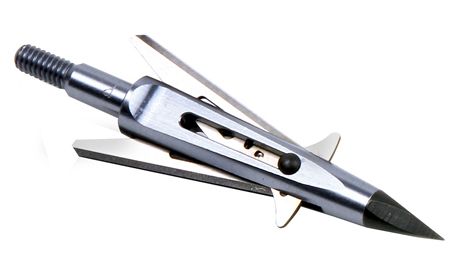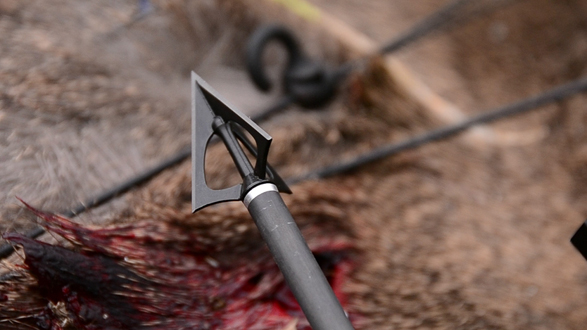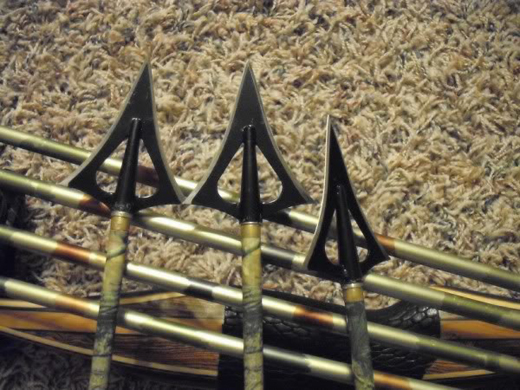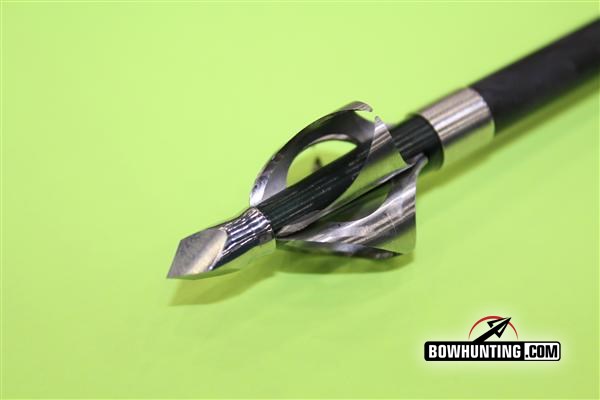LAST UPDATED: May 1st, 2015
It’s been said that opinions are kind of like elbows…everybody’s got a couple of them. But when it comes to the features that help leading broadhead options stand out above the rest, there seems to be some common ground in what most bowhunters look for in the common factors of a deadly broadhead. In surveying bowhunters across the country, it quickly became clear that three common factors stood out as “must-have” features in a broadhead. Accuracy, Durability, and Sharpness were the “Big 3” when it came to desirable qualities in a hunting head. Penetration followed closely behind, and cutting diameter, despite the big push by many manufactures for larger cutting diameter heads, brought up the rear. This month we’ll check out a few of the hot new heads in the business, as well as hear from the ones that bring us unique quality and design in some of the deadliest broadheads in the business.
Top broadheads like the NAP Hellrazor (pictured here) will fly like darts, withstand heavy impact with bone and leave a blood trail anyone can follow.
To say broadheads have evolved in the last ten years would be quite the understatement. There has been a seemingly endless effort to meet the demands of bowhunters wanting tougher, straighter, and sharper broadheads. In some cases, the technology has been quite impressive, while others seem to be doing their best to reinvent the wheel when it comes to manufacturing broadheads. To gain a little perspective, we’ll visit with broadhead owners from both ends of the evolution process. We’ll look at a broadhead design that’s been around longer than some of us bowhunters have been alive, as well as one incredibly fresh approach that’s creating a lot of buzz in the bowhunting industry right now.
Time Tested Performance
Dave Oligee acquired Simmons Sharks Broadheads (simmonssharks.com) from bowhunting legend, Jerry Simmons. Mr. Jerry has killed more deer with his bow than most men on this earth. He knew what worked – and what didn’t – when he created his design for the Simmons Sharks broadhead in 1973. The head accomplished what many manufactures strive to accomplish today. The Simmons Sharks heads were tough, cut great holes, and allowed the hunter to use the same head over and over again due to the integrity built in to each head. Little has changed with this head. They are still one of the deadliest heads in the business. Oligee took a minute to share a few of the factors that make the Shark such a great performing broadhead.
The Simmons Shark broadhead design has stood the test of time simply because it works.
“Two of the leading factors in broadhead performance are arrow flight and penetration,” says Oligee. “There are others but they typically come from these two factors. Due to the lack of surface area caused by the use of the concave edge, Simmons Sharks excel at both. Most other companies use a straight or convex edge to simplify the grinding operation. This limits them in the width of cut because the wider they get the more planing surface they gain. The result is poor arrow flight. Another negative result is poor penetration. Nothing out-penetrates a cut on contact two-blade broadhead. But when you couple a cut on contact broadhead with less surface area, and a wide cutting width like Simmons, you have the best of both worlds. The concave edge design of the Simmons head was created to help it cut holes considerably larger than the actual width of the head.” The Simmons head continues to perform on the toughest of game around the world due to the integrity built into its design. The more things change, the more they stay the same. And that works well for the performance found in Simmons.
Radical Innovation
But let’s fast-forward to 2013 and take a look at a radically new design in the broadhead world. The new Toxic broadhead from Flying Arrow Archery (flyingarrowmontana.com) created quite a buzz at this year’s ATA show in Louisville, KY. Unlike anything we’ve ever seen, the Toxic head was designed to offer the advantages of a mechanical head, with the dependability of a fixed-blade design. Having owned Rocket Aeroheads and having multiple mechanical and fixed blade broadheads in his lineup, Chris Rager (owner/designer of Toxic) knew personally what archers were looking for – a broadhead that would fly straight and create the most hemorrhage in an effort to harvest an animal as quickly and humanely as possible. Chris has used about every fixed blade and mechanical broadhead on the market in an effort to discover the perfect broadhead. Chris is partial to a fixed blade broadhead because of their resilience and low profile but likes the mechanical broadheads because of their flight characteristics and wound channel.
The new Toxic broadhead is unlike anything else on the market and may take broadhead design in a new direction; only time will tell.
“When I designed the “Toxic” broadhead, I wanted to design a fixed blade head that would outperform the more popular mechanicals but without all of the pitfalls associated with them (blades rattling, blades popping open while in the quiver or during a stalk, moving parts, O-rings, rubber bands and clips for blade retention),” says Rager. The last time I checked, elk ribs were barely an inch apart. So while these companies are boasting huge cutting diameters, we went the other way. Trying to shoot a 1 ½ to 2 inch broadhead through a 1-inch gap would obviously make contact with bone. The Toxic has 7/8” cutting diameter therefore reducing an archer’s chance of hitting bone by half. But with the Toxic’s unique design, it has almost 5-inches of actual cutting surface. Whereas, a large 3-blade mechanical has approximately 3 ½ inches of cutting surface.”
But what good is a radical broadhead if it isn’t accurate? “This is where the Toxic really shines,” says Rager. “It has a single-edge bevel cut on the inside of the blade. This helps serve two purposes: 1) it helps direct the airflow through the blades and on to the arrow shaft instead of away from the blade and away from the arrow shaft. This significantly helps the arrow fletching do their job properly. Hence, extraordinary accuracy and quietness during flight. 2) As the broadhead encounters more resistance, whether meat, hair or bones, the blades will flex open allowing whatever to pass through with minimal resistance, provide good penetration and leaving a wound channel that speaks for itself.
While we were doing penetration test on ¾ inch plywood, we admit that the Toxic will not out penetrate a conventional 2 or 3 blade fixed blade broadhead. That’s obvious because it has double the cutting surface. But when compared to the mechanicals, the mechanicals would sheer their blades off, curl the blades to nothing, or fold the blades back so far it would ruin the broadhead’s ferrule. The Toxic held together. The blades would flex open but would stay in place. The Archer could simply unscrew the tip, slide the blades out the front, slide new blades in, screw the tip down and be ready to roll again in minimal time.” Be sure to keep an eye on the Toxic broadhead this spring as it begins to cause death to a countless number of turkey and black bears across the country.
Deep & Wide
The folks at NAP (newarchery.com) are no stranger to deadly broadhead design. They have continued to offer some of the leading broadhead designs for archers around the world. For 2013, NAP has introduced a killer new head to continue on their line of success in the field. The new Killzone MAXX is a 2 blade rear-deploying broadhead that packs a devastating 2 3/8″ cutting diameter. The field-point accurate Killzone Maxx uses NAP’s unique spring-clip design which ensures your blades won’t open in flight or in your quiver. There are no o-rings or rubber bands to worry about.

NAP has changed the way bowhunters look at mechanicals thanks to their rugged, fail-safe design that guarantees they perform exactly the way they are supposed to. Pictured here is the NAP KILLZONE.
And for those shooting lighter poundage bows, NAP has introduced the new Killzone Low KE. The Low KE design is a 2 blade rear-deploying broadhead that packs a 1 3/4″ cutting diameter for extreme penetration and devastating wound channels. The field-point accurate Killzone Low KE also uses NAP’s unique spring-clip design which ensures your blades won’t open in flight or in your quiver. Like the Killzone MAXX, there are no o-rings or rubber bands to worry about. The Killzone Low KE is designed for use in bows up to 350 fps.
Conclusion
Regardless of where you find yourself on the scale of broadhead evolution, you will no doubt find a head that will meet your every need from hunting spring turkey to bugling bulls in the fall. And whether you prefer a more traditional fixed blade design, or the radical innovation of modern times, the facts remain the same. Shoot straight…stay tough…and cut deadly holes. It’s what we’re after every time we drop the string.
Brodie Swisher is a world champion game caller, outdoor writer, and seminar speaker. Check out his website at www.thrutheseason.com.

 By
By 






